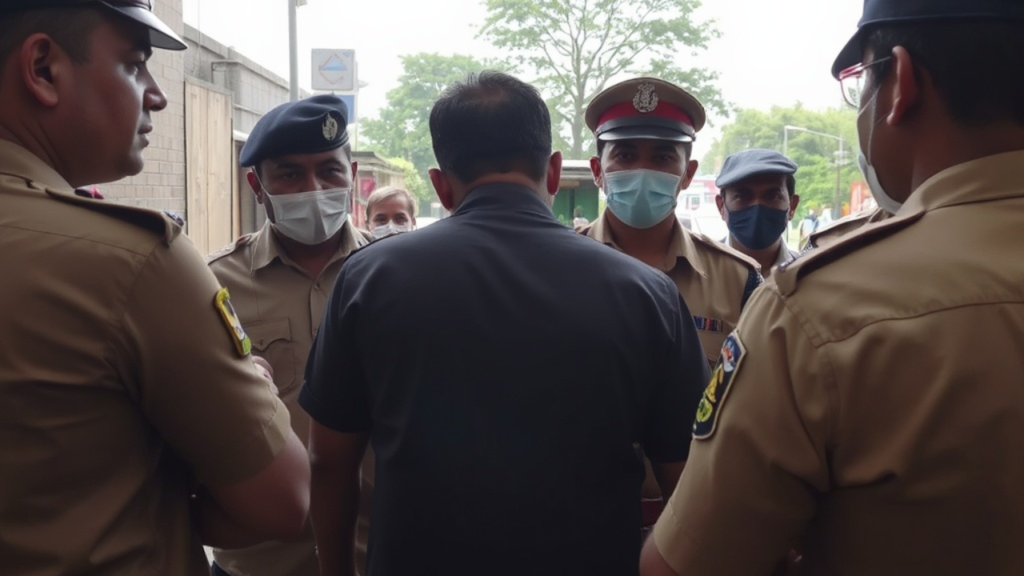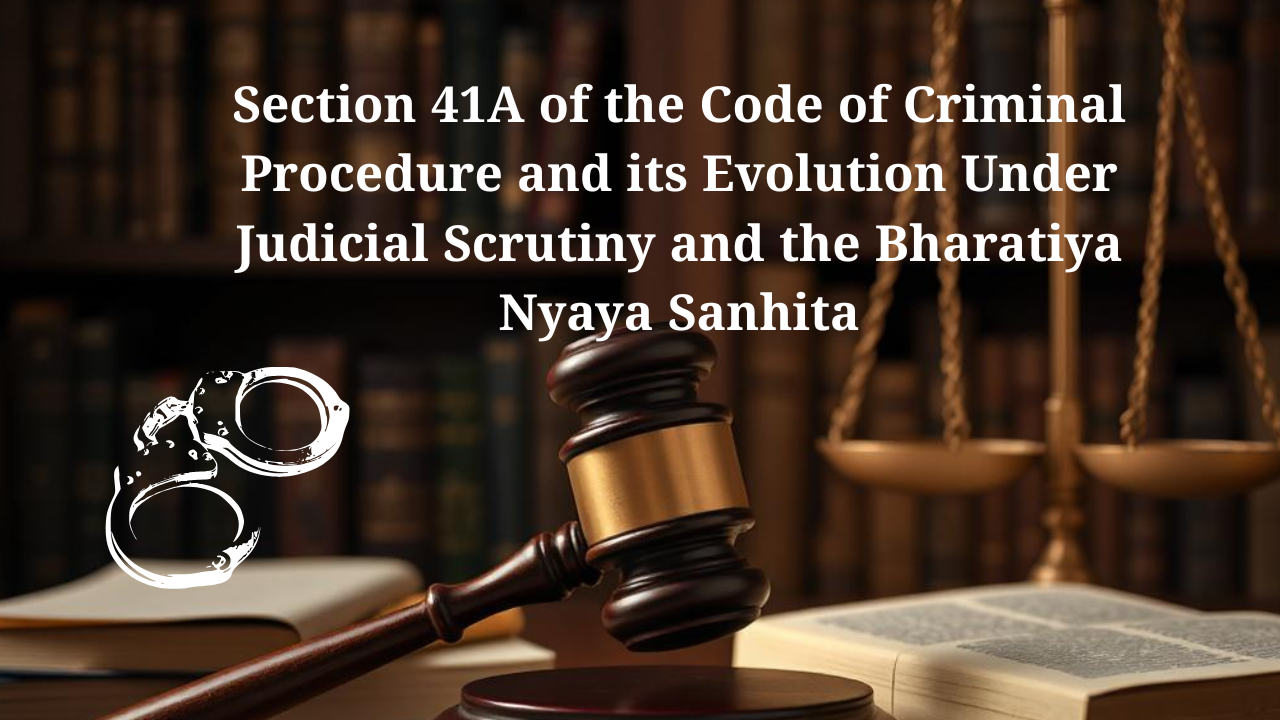Section 41A of the Code of Criminal Procedure and its Evolution Under Judicial Scrutiny and the Bharatiya Nyaya Sanhita
I. Introduction: Safeguarding Liberty Through Procedural Compliance
The concept of arrest within criminal procedure holds significant weight, directly impacting the personal liberty of individuals. Recognizing the potential for misuse and the fundamental right to freedom enshrined in the Constitution of India, the legislature introduced Section 41A into the Code of Criminal Procedure (CrPC) in 2010. This provision aimed to establish a procedural safeguard by mandating the issuance of a notice of appearance before a police officer in cases where the arrest of a person is not deemed necessary under the provisions of Section 41(1) of the CrPC, particularly for offenses punishable with imprisonment up to seven years.
The practical application and the mandatory nature of compliance with this provision have been significantly shaped by judicial interpretations rendered by the Supreme Court of India and various High Courts, including the Bombay High Court. Recently, the Indian legislative landscape witnessed the enactment of the Bharatiya Nyaya Sanhita (BNSS), which includes a corresponding provision, thereby necessitating a comparative analysis of the procedural aspects.
This paper undertakes a comprehensive analysis of the procedure stipulated under Section 41A of the CrPC, as interpreted by the Supreme Court and the Bombay High Court up to March 31, 2025. The primary objective is to provide an in-depth understanding of the legislative text, the landmark judicial pronouncements that have defined its application, and the implications of the corresponding provision, Section 35, within the newly enacted BNSS.
This analysis will encompass a detailed examination of the textual framework of Section 41A, the key judgments that have elucidated its procedural requirements, the specific interpretations and applications by the Bombay High Court to address regional contexts, and a comparative study with Section 35 of the BNSS, highlighting the procedural changes introduced and their potential impact on the existing judicial understanding. The inclusion of judgments from the Bombay High Court is crucial to capture the nuances in the regional application of this significant legal provision.
The introduction of Section 41A reflects a deliberate legislative effort to prioritize individual liberty by positioning arrest as an exception rather than the norm for certain categories of offenses. Judicial pronouncements have further reinforced this fundamental principle by emphasizing the mandatory nature of compliance for law enforcement agencies and establishing mechanisms for accountability. The subsequent transition to the BNSS necessitates a critical examination of whether this focus on safeguarding individual rights through procedural checks and balances is maintained or undergoes any significant alterations in the new legislative framework.

II. Unpacking Section 41A of the CrPC: A Legislative Mandate for Notice
Section 41A of the Code of Criminal Procedure, titled “Notice of appearance before police officer,” lays down a specific procedure to be followed by police officers in cases where arrest is not immediately warranted.
Sub-section (1) of Section 41A explicitly states that “[t]he police officer shall, in all cases where the arrest of a person is not required under the provisions of sub-section (1) of section 41, issue a notice directing the person against whom a reasonable complaint has been made, or credible information has been received, or a reasonable suspicion exists that he has committed a cognizable offence, to appear before him or at such other place as may be specified in the notice”. This sub-section establishes a mandatory obligation on the police officer to issue such a notice in the specified circumstances, highlighting the legislative intent to prefer summoning for investigation over immediate arrest.
Sub-section (2) imposes a corresponding duty on the individual receiving the notice, stating, “[w]here such a notice is issued to any person, it shall be the duty of that person to comply with the terms of the notice”. This underscores the legal obligation of the person concerned to cooperate with the investigation by adhering to the directions outlined in the notice.
Sub-section (3) provides a safeguard for individuals who comply with the notice: “[w]here such person complies and continues to comply with the notice, he shall not be arrested in respect of the offence referred to in the notice unless, for reasons to be recorded, the police officer is of the opinion that he ought to be arrested”. This clause emphasizes that compliance with the notice generally protects the individual from arrest for the offense in question, unless the police officer, for justifiable reasons that must be documented, believes arrest is necessary.
Finally, sub-section (4) outlines the consequences of non-compliance: “[w]here such person, at any time, fails to comply with the terms of the notice or is unwilling to identify himself, the police officer may, subject to such orders as may have been passed by a competent Court in this behalf, arrest him for the offence mentioned in the notice”. This provision grants the police officer the authority to arrest an individual who fails to adhere to the notice or refuses to identify themselves, albeit subject to any orders passed by a competent court.
The underlying rationale for introducing Section 41A was primarily to address the issue of unwarranted arrests, particularly in relation to offenses punishable with imprisonment for a term which may be less than seven years or which may extend to seven years. The legislative intent was to ensure that arrests are not carried out routinely or mechanically upon the registration of a First Information Report (FIR), but rather based on a considered assessment of necessity and with reasons duly recorded, thereby aligning with the constitutional principles safeguarding personal liberty under Article 21.
Section 41A operates in close conjunction with Section 41 of the CrPC, which specifies the circumstances under which a police officer may arrest a person without an order from a Magistrate and without a warrant. Section 41A becomes applicable in situations where the stringent conditions for immediate arrest as laid down in Section 41(1) are not met. This interplay between the two sections establishes a tiered approach to law enforcement, where the issuance of a notice for appearance is the primary course of action, and arrest is reserved for cases that satisfy specific criteria of necessity outlined in Section 41.
III. Supreme Court’s Pronouncements: Shaping the Contours of Section 41A Procedure
The Supreme Court of India has played a pivotal role in interpreting and clarifying the procedural requirements and the mandatory nature of Section 41A of the CrPC through several landmark judgments.
The judgment in Arnesh Kumar v. State of Bihar (2014) stands as a cornerstone in the jurisprudence surrounding Section 41A. This case arose from concerns regarding the misuse of Section 498A of the Indian Penal Code (IPC) and the prevalent practice of routine arrests in such cases. Recognizing the importance of personal liberty, the Supreme Court issued a set of comprehensive guidelines that, while originating from a case under Section 498A IPC, were explicitly made applicable to all cases where the offense is punishable with imprisonment for a term which may be less than seven years or which may extend to seven years, whether with or without fine.
These guidelines mandate that police officers should not automatically arrest upon the registration of a case but must satisfy themselves about the necessity for arrest based on the parameters laid down under Section 41 CrPC. The Court also directed that all police officers be provided with a checklist containing the specified sub-clauses under Section 41(1)(b)(ii) of the CrPC, and this checklist, duly filled, along with the reasons and materials necessitating the arrest, must be forwarded to the Magistrate while producing the accused for further detention. The Magistrate, in turn, is duty-bound to peruse this report and record their satisfaction before authorizing detention, ensuring that detention is not authorized casually or mechanically.
Furthermore, the decision not to arrest an accused must be communicated to the Magistrate within two weeks from the date of the institution of the case, and a notice of appearance in terms of Section 41A CrPC must be served on the accused within the same timeframe. The Supreme Court also emphasized the liability of police officers for departmental action and contempt of court for non-compliance with these directions, and the liability of Magistrates for departmental action for authorizing detention without recording reasons. The Arnesh Kumar judgment fundamentally shifted the understanding of Section 41A, transforming it from a seemingly discretionary provision into one with strict mandatory compliance requirements, underscoring the judiciary’s commitment to safeguarding personal liberty.
The case of Satender Kumar Antil v. CBI (2022 & 2025) further reinforced the mandatory nature of compliance with Section 41A. The Supreme Court noted the absence of specific guidelines regarding the mandatory compliance of Section 41A and reiterated the importance of following the procedure laid down under Sections 41 and 41A CrPC. The Court directed all State Governments and Union Territories to facilitate the issuance of Standing Orders in accordance with these procedural requirements.
Notably, in a hearing in 2025, the Supreme Court explicitly ruled against the service of Section 41A notices (and Section 35 BNSS notices) via WhatsApp or other electronic modes, emphasizing the necessity for strict adherence to the prescribed modes of service under the CrPC/BNSS. The Court upheld the Delhi High Court’s rulings in Rakesh Kumar v. Vijayanta Arya and Amandeep Singh Johar v. State (NCT Delhi) in this regard, underscoring the importance of formal procedural adherence. The Supreme Court also directed High Courts to monitor compliance with these directives. This judgment further solidified the mandatory nature of Section 41A compliance and emphasized the need for formal service of notices.
The Delhi High Court’s judgment in Amandeep Singh Johar v. State of NCT of Delhi (2018), later upheld by the Supreme Court, laid down a detailed procedure to be strictly followed by police officers while issuing notices under Section 41A CrPC. This procedure includes the mandatory issuance of notices in the prescribed format, formal service of the notice in accordance with Chapter VI of the CrPC, recording of reasons if an alternative time for appearance is sought by the accused, issuance of an acknowledgement upon appearance, attestation of the acknowledgement by an independent witness if the appearance is at a place other than the police station, and the maintenance of indexed booklets containing serially numbered notices in triplicate.
The judgment also specifies considerations for questioning women and juveniles. These granular details emphasize the need for procedural exactitude to ensure transparency and prevent any potential for ambiguity or harassment during the process of summoning an accused person for investigation.

IV. Bombay High Court’s Perspective: Application and Interpretation in Specific Contexts
The Bombay High Court has also actively engaged with the provisions of Section 41A CrPC, contributing to its interpretation and application within its jurisdiction. Several judgments from the Bombay High Court highlight its approach to the mandatory nature of Section 41A notice before arrest and the consequences of non-compliance.
In a recent significant development, a division bench of the Bombay High Court, while hearing multiple petitions concerning arrest procedures, referred key questions to a larger bench, citing “total confusion” in the procedural aspects of arrest. The questions referred to the larger bench include whether the grounds of arrest must be communicated to an accused in writing and whether a prior notice under Section 41A is mandatory before an arrest is made, not just in specific instances but potentially in all cases, even those involving serious offenses.
The court noted instances where accused persons in serious crimes have leveraged procedural lapses to secure bail, emphasizing the need for clear and definite guidelines to ensure uniformity across courts and law enforcement agencies. This referral to a larger bench underscores the ongoing judicial deliberations and the quest for clarity regarding the application of these crucial safeguards, particularly in balancing the rights of the accused with those of victims and society in heinous crimes.
However, the Bombay High Court has also, in various instances, reiterated the importance of complying with Section 41A and the guidelines laid down by the Supreme Court. For instance, in a case noted in the research material , the Bombay High Court emphasized that the police must comply with Section 41A of the CrPC and follow the ratio laid down by the Supreme Court in the Satender Kumar Antil case. The court considered the argument that no accused can claim that they must be served with a notice under Section 41A as a matter of right, but ultimately stressed the need for the police to justify the necessity of arrest by recording reasons as mandated by law.
These instances demonstrate the Bombay High Court’s commitment to ensuring the effective implementation of Section 41A within its jurisdiction, often aligning with the Supreme Court’s emphasis on procedural compliance. The ongoing reference to a larger bench signifies a continuous effort to refine the interpretation and application of these safeguards, particularly in complex scenarios involving serious offenses.
V. Transition to the Bharatiya Nyaya Sanhita (BNSS): A New Legislative Chapter
The Indian legal framework for criminal procedure is undergoing a significant transformation with the enactment of the Bharatiya Nyaya Sanhita, 2023. While the exact date for the provisions related to criminal procedure to come into force as of this writing (prior to March 31, 2025) may vary, the legislative intent is clear to replace the existing CrPC with the BNSS.
Section 35 of the Bharatiya Nagarik Suraksha Sanhita, 2023, has been identified as the provision corresponding to Section 41A of the CrPC. The full text of Section 35 of the BNSS, as available in the research snippets, provides insights into the new legislative framework:
(1) Any police officer may without an order from a Magistrate and without a warrant, arrest any person – (a) who commits, in the presence of a police officer, a cognizable offence; or (b) against whom a reasonable complaint has been made, or credible information has been received, or a reasonable suspicion exists that he has committed a cognizable offence punishable with imprisonment for a term which may be less than seven years or which may extend to seven years whether with or without fine, if the police officer has reason to believe on the basis of such complaint, information, or suspicion that such person has committed the said offence; and the police officer is satisfied that such arrest is necessary –
(i) to prevent such person from committing any further offence; or
(ii) for proper investigation of the offence; or
(iii) to prevent such person from causing the evidence of the offence to disappear or tampering with such evidence in any manner; or
(iv) to prevent such person from making any inducement, threat or promise to any person acquainted with the facts of the case so as to dissuade him from disclosing such facts to the Court or to the police officer; or
(v) as unless such person is arrested, his presence in the Court whenever required cannot be ensured, and the police officer shall record his reasons in writing while making such arrest: Provided that in case of an offence punishable with imprisonment for a term which may be less than three years, the arrest shall be made only with the prior permission of an officer not below the rank of Deputy Superintendent of Police. Provided further that the police officer shall record the reasons in writing for not making the arrest in a case where the arrest is not required.
(c) against whom credible information has been received that he has committed a cognizable offence punishable with imprisonment for a term which may extend to more than seven years whether with or without fine or with death sentence and the police officer has reason to believe on the basis of that information that such person has committed the said offence.
(d) who has been proclaimed as an offender either under this Sanhita or by an order of the State Government.
(e) in whose possession anything is found which may reasonably be suspected to be stolen property and who may reasonably be suspected of having committed an offence with reference to such thing.
(f) who obstructs a police officer while in the execution of his duty, or who has escaped, or attempts to escape, from lawful custody.
(g) who is reasonably suspected of being a deserter from any of the Armed Forces of the Union.
(h) who has been concerned in, or against whom a reasonable complaint has been made, or credible information has been received, or a reasonable suspicion…source
(i) who, being a released convict, commits a breach of any rule made under sub-section (5) of section 394.
(j) for whose arrest any requisition, whether written or oral, has been received from another police officer, provided that the requisition specifies the person to be arrested and the offence or other cause for which the arrest is to be made and it appears therefrom that the person might lawfully be arrested without a warrant by the officer who issued the requisition.
(2) Subject to the provisions of section 39, no person concerned in a non-cognizable offence or against whom a complaint has been made or credible information has been received or reasonable suspicion exists of his having so concerned, shall be arrested except under a warrant or order of a Magistrate.
(3) The police officer shall, in all cases where the arrest of a person is not required under sub-section (1) issue a notice directing the person against whom a reasonable complaint has been made, or credible information has been received, or a reasonable suspicion exists that he has committed a cognizable offence, to appear before him or at such other place as may be specified in the notice.
(4) Where such a notice is issued to any person, it shall be the duty of that person to comply with the terms of the notice.
(5) Where such person complies and continues to comply with the notice, he shall not be arrested in respect of the offence referred to in the notice unless, for reasons to be recorded, the police officer is of the opinion that he ought to be arrested.
(6) Where such person, at any time, fails to comply with the terms of the notice or is unwilling to identify himself, the police officer may, subject to such orders as may have been passed by a competent Court in this behalf, arrest him for the offence mentioned in the notice.
(7) No arrest shall be made without prior permission of an officer not below the rank of Deputy Superintendent of Police in case of an offence which is punishable for imprisonment of less than three years and such person is infirm or is above sixty years of age.
The enactment of the BNSS signifies a substantial overhaul of India’s criminal justice system. The identification of Section 35 as the successor to Section 41A necessitates a careful examination of the textual and procedural changes to understand how the legislative framework for issuing notices of appearance has been modified in this transition. This legislative change will directly impact the future application and interpretation of these crucial safeguards against unnecessary arrests.
VI. Comparative Analysis: Section 41A CrPC vs. Section 35 BNSS
A detailed comparison of Section 41A CrPC and Section 35 BNSS reveals several textual and procedural changes, additions, and omissions.
While the core principle of issuing a notice of appearance in cases where arrest is not required under Section 41(1) remains consistent in both Section 41A CrPC and Section 35(3) BNSS, there are notable structural differences. Section 35 of the BNSS amalgamates provisions related to both arrest without a warrant (which corresponds to Section 41 of the CrPC) and the notice of appearance (corresponding to Section 41A of the CrPC) into a single section. This consolidation aims to streamline the legal framework concerning arrest.
A significant addition in Section 35 BNSS is sub-section (7), which was not present in Section 41A CrPC. This new provision mandates that “[n]o arrest shall be made without prior permission of an officer not below the rank of Deputy Superintendent of Police in case of an offence which is punishable for imprisonment of less than three years and such person is infirm or is above sixty years of age”. This introduces an additional layer of protection for elderly and infirm individuals in cases involving less serious offenses, requiring a higher level of authorization before an arrest can be made.
Furthermore, Section 35(3) of the BNSS, which corresponds to Section 41A(1) of the CrPC, explicitly states that the police officer shall issue a notice in all cases where arrest is not required under sub-section (1). This aligns with the principles established in the Lalita Kumari judgment, which emphasized the need for a preliminary inquiry before registering an FIR in cases of offenses punishable with less than seven years of imprisonment. The incorporation of this principle in the BNSS potentially makes the issuance of notice before arrest in such cases more explicitly mandatory.
The procedural implications of these changes are significant. The consolidation of arrest provisions in Section 35 BNSS might influence how law enforcement agencies approach the decision-making process regarding arrest and notice. The introduction of sub-section (7) necessitates a change in the arrest procedure for elderly and infirm individuals in minor offenses, requiring prior approval from a senior police officer.
This is expected to reduce unnecessary arrests of vulnerable individuals in less serious cases. The integration of the Lalita Kumari principles in Section 35(3) could lead to a more consistent and mandatory practice of issuing notices of appearance in offenses punishable with less than seven years, further safeguarding against arbitrary arrests.
| Feature | Section 41A CrPC | Section 35 BNSS | Key Change/Addition |
|---|---|---|---|
| Core Principle | Mandatory notice of appearance when arrest under Section 41(1) is not required. | Mandatory notice of appearance when arrest under Section 35(1) is not required (Section 35 amalgamates CrPC Sections 41 & 41A). | Consolidation of arrest provisions into a single section. |
| Issuance of Notice | Police officer shall issue notice. | Police officer shall issue notice (explicitly in sub-section 3). | Reinforces mandatory nature. |
| Compliance with Notice | Duty to comply. | Duty to comply. | No change. |
| Protection from Arrest (upon compliance) | Shall not be arrested unless reasons recorded for necessity of arrest. | Shall not be arrested unless reasons recorded for necessity of arrest. | No change. |
| Arrest upon Non-compliance | Police officer may arrest, subject to court orders. | Police officer may arrest, subject to court orders. | No change. |
| New Provision | Not present. | Sub-section (7): Prior permission of DSP required for arrest in offenses punishable with less than 3 years for infirm or individuals above 60 years. | Significant new safeguard for vulnerable individuals in minor offenses. |
Table 1: Comparison of Section 41A CrPC and Section 35 BNSSVII. Synthesizing Judicial Interpretations with BNSS Changes: The Evolving Procedure
The body of jurisprudence developed by the Supreme Court concerning Section 41A of the CrPC is highly likely to remain relevant and applicable to the interpretation of Section 35 of the BNSS, given the substantial overlap in their core objectives and principles. The Supreme Court’s explicit reference to Section 35 BNSS alongside Section 41A CrPC in its rulings against electronic service of notice strongly indicates an intention for the same procedural safeguards to continue under the new legislation.
Therefore, the mandatory compliance requirements established in Arnesh Kumar, the emphasis on formal service reiterated in Satender Kumar Antil, and the detailed procedural guidelines for issuance of notice outlined in Amandeep Singh Johar are expected to form the foundational framework for interpreting Section 35 BNSS.
However, the BNSS-specific changes will likely necessitate further judicial interpretation. The introduction of sub-section (7) in Section 35, concerning the arrest of elderly or infirm individuals for offenses punishable with less than three years, will require courts to define the scope of “infirm” and clarify the process for obtaining prior permission from an officer not below the rank of Deputy Superintendent of Police. Similarly, the amalgamation of arrest provisions in Section 35 might lead to judicial pronouncements on how courts should interpret the relationship between the grounds for arrest under sub-section (1) and the issuance of notice under sub-section (3). The explicit incorporation of Lalita Kumari principles in Section 35(3) could result in stricter enforcement of the pre-FIR inquiry requirement in cases where a notice of appearance is contemplated.
The Bombay High Court, with its ongoing deliberations on arrest procedures under the CrPC, will play a crucial role in interpreting and applying Section 35 BNSS within its jurisdiction. The questions currently before the larger bench of the Bombay High Court regarding the mandatory provision of written grounds of arrest and the applicability of Section 41A in all cases are highly relevant to the future interpretation of Section 35 BNSS. The clarity sought by the Bombay High Court on these aspects under the CrPC will undoubtedly inform its approach to the corresponding provisions in the BNSS, contributing to a more nuanced understanding of the evolving legal landscape.
VIII. Implications of the BNSS Amendments on the Existing Judicial Framework
The amendments introduced in Section 35 BNSS largely appear to codify and affirm the principles established through judicial interpretations of Section 41A CrPC. The emphasis on the issuance of notice of appearance as a primary step and the restriction on unnecessary arrests, particularly in cases involving less severe offenses, aligns with the spirit of the Supreme Court’s guidelines. The introduction of a specific safeguard for elderly and infirm individuals in sub-section (7) represents a progressive legislative step that resonates with the broader judicial concern for protecting the fundamental rights of vulnerable populations.
However, the new legislative text does not explicitly overrule any existing judicial interpretations. Instead, it builds upon them by incorporating principles like those from the Lalita Kumari judgment. While the core principles remain consistent, ambiguities or nuances in the application of the new provisions, such as the definition of “infirm” in sub-section (7), will likely require further clarification through judicial pronouncements.
The introduction of these new provisions in the BNSS is expected to impact the practical procedures followed by law enforcement agencies. The added requirement of prior permission for the arrest of elderly and infirm individuals in minor offenses will necessitate a change in protocol and a greater degree of scrutiny at the level of the Deputy Superintendent of Police. The consolidation of arrest provisions in Section 35 might also encourage a more holistic approach by police officers when deciding between immediate arrest and issuing a notice of appearance.
IX. Conclusion: Navigating the Evolving Landscape of Notice and Arrest
This analysis has highlighted the critical role of Section 41A of the CrPC in establishing a procedural safeguard against unnecessary arrests, particularly for offenses punishable with imprisonment up to seven years. The Supreme Court’s landmark judgments in Arnesh Kumar, Satender Kumar Antil, and Amandeep Singh Johar have been instrumental in shaping the mandatory compliance and detailed procedures associated with this provision. The Bombay High Court’s engagement with Section 41A reflects a regional commitment to upholding these principles, with ongoing judicial deliberations seeking further clarity on its application, especially in the context of serious offenses.
The transition to the Bharatiya Nyaya Sanhita and the introduction of Section 35, the corresponding provision, mark a new chapter in this evolving legal landscape. While Section 35 largely mirrors the core principles of Section 41A, it introduces notable changes such as the consolidation of arrest provisions and a specific safeguard for elderly and infirm individuals in less serious offenses. The existing body of judicial interpretations of Section 41A is expected to provide a strong foundation for the interpretation of Section 35 BNSS. However, the new legislative provisions will likely necessitate further judicial scrutiny to clarify their scope and application.
In conclusion, provisions like Section 41A CrPC and Section 35 BNSS underscore the critical importance of procedural safeguards in balancing the state’s duty to enforce the law effectively with the fundamental right of individuals to personal liberty within a democratic framework. The continued judicial engagement and interpretation of these provisions will be crucial in ensuring their effective implementation and upholding the principles of fairness and due process in the Indian criminal justice system up to March 31, 2025, and beyond.
Landmark Judgments (Primarily Supreme Court):
- Arnesh Kumar v. State of Bihar & Anr. (2014) 8 SCC 273:
- The Foundational Judgment: This is arguably the most crucial judgment concerning Sections 41 and 41A.
- Key Holdings:
- Mandated strict compliance with Section 41A for all cases where the offence is punishable with imprisonment up to 7 years, whether with or without fine.
- Police officers must record reasons before making an arrest under Section 41(1)(b) (based on reasonable complaint, credible information, or reasonable suspicion) and also reasons for not making an arrest.
- Directed that a notice of appearance under Section 41A must be served on the accused within two weeks from the date of institution of the case, if arrest is not immediately required.
- Emphasized that the decision to arrest must be based on the necessity specified in Section 41(1)(b)(ii) (e.g., preventing further offence, proper investigation, preventing tampering/threats, ensuring court appearance).
- Magistrates must scrutinize the reasons recorded by the police before authorizing detention under Section 167 CrPC and must record their own satisfaction.
- Warned that failure to comply by police officers would render them liable for departmental action and contempt of court.
- Significance: Set definitive guidelines to prevent routine and mechanical arrests, making Section 41A a vital procedural safeguard.

- Rini Johar & Anr. v. State of M.P. & Ors. (2016) 11 SCC 703:
- While dealing broadly with illegal arrest and compensation, this case reinforced the principles laid down in Arnesh Kumar, highlighting the importance of following due procedure (including the spirit of Section 41A) to protect citizens’ liberty.
- Significance: Underlined the consequences (including potential state liability) of arbitrary arrests made in violation of established procedures and guidelines.
- Social Action Forum for Manav Adhikar & Anr. v. Union of India (2018) 10 SCC 443:
- This judgment dealt with the misuse of Section 498A IPC (dowry harassment) and issued directions to prevent automatic arrests.
- Key Holdings: It reiterated the directions given in Arnesh Kumar and emphasized their mandatory application, particularly in matrimonial disputes, reinforcing the need to utilize Section 41A instead of making immediate arrests.
- Significance: Specifically applied the Arnesh Kumar guidelines (and thus the importance of Section 41A) to the context of Section 498A IPC cases.
- Siddharth v. State of U.P. & Anr. (2021) SCC OnLine SC 615 / (2022) 1 SCC 676:
- Key Holdings: Clarified that the arrest of an accused is not a prerequisite for filing a charge sheet. If the accused has cooperated with the investigation, including appearing pursuant to Section 41A notices, their arrest is generally not required merely for the purpose of filing the final report/charge sheet. The court stressed adherence to Sections 41 and 41A.
- Significance: Delinked the filing of a charge sheet from the necessity of arrest, promoting compliance with Section 41A and preventing arrests made solely for procedural completion when the accused is cooperative.
- Satender Kumar Antil v. Central Bureau of Investigation & Anr. (2022) 10 SCC 51:
- A Comprehensive Reinforcement: This landmark judgment on bail jurisprudence extensively discussed and forcefully reiterated the importance of Sections 41 and 41A.
- Key Holdings:
- Strongly reaffirmed the mandatory nature of the guidelines laid down in Arnesh Kumar.
- Stated unequivocally that non-compliance with Sections 41 and 41A would entitle the accused to be released on bail.
- Directed State Governments and Union Territories to facilitate compliance and sensitize police officers.
- Urged courts (Magistrates and Sessions Courts) to ensure compliance with Sections 41 and 41A when dealing with remand and bail applications.
- Categorized offences for the purpose of bail and emphasized that for Category A offences (punishable up to 7 years), compliance with Sections 41/41A is essential.
- Significance: Elevated the compliance with Section 41A to a critical factor in granting bail, putting significant pressure on both police and lower judiciary to adhere to the procedure. It is a major contemporary authority on the subject.
- Md. Asfak Alam v. State of Jharkhand & Anr. (2023) SCC OnLine SC 892:
- Recent Reiteration: The Supreme Court again expressed dismay over the continued non-compliance with Sections 41/41A and the Arnesh Kumar guidelines.
- Key Holdings: Reiterated the directions from Arnesh Kumar and Satender Kumar Antil. Emphasized the duty of all courts to ensure these provisions are followed. Specifically mentioned that compliance should be checked even while considering anticipatory bail applications under Section 438 CrPC. Warned against casual and mechanical arrests.
- Significance: Shows the Supreme Court’s ongoing concern and vigilance regarding the implementation of Section 41A and its commitment to preventing unnecessary deprivation of liberty.
Works cited
1. Section 41A – India Code, https://www.indiacode.nic.in/show-data?actid=AC_CEN_5_23_000010_197402_1517807320555&orderno=43 2. DGP circular dt 12.03.19- Procedure for sending notice and acknowledgment us 41-A CrPC.pdf – Puducherry Police, https://police.py.gov.in/DGP%20circular%20dt%2012.03.19-%20Procedure%20for%20sending%20notice%20and%20acknowledgment%20us%2041-A%20CrPC.pdf 3. Handling False FIRs & Section 41A CRPC: Key Legal Steps – Zolvit, https://www.zolvit.com/blog/false-fir-section-41a-crpc-legal-steps/ 4. Upholding procedural compliance, Supreme Court reaffirms …, https://cjp.org.in/upholding-procedural-compliance-supreme-court-reaffirms-electronic-service-of-notices-under-section-41a-crpc-section-35-bnss-as-invalid/ 5. HC refers key arrest procedure issues to larger bench | Mumbai …, https://www.hindustantimes.com/cities/mumbai-news/hc-refers-key-arrest-procedure-issues-to-larger-bench-101738349974416.html 6. Bombay High Court seeks clarity on arrest procedures, refers case to larger bench, https://www.indiatoday.in/india/law-news/story/bombay-high-court-clarity-arrest-procedures-crpc-case-larger-bench-2673280-2025-02-01 7. Bombay high court calls for clear guidelines on furnishing grounds of arrest, refers issue to larger bench | Pune News – The Times of India, https://timesofindia.indiatimes.com/city/pune/bombay-high-court-calls-for-clear-guidelines-on-furnishing-grounds-of-arrest-refers-issue-to-larger-bench/articleshow/117802669.cms 8. Section 41A of CrPC – Drishti Judiciary, https://www.drishtijudiciary.com/current-affairs/section-41a-of-crpc 9. Supreme Court Bars Service Of Section 41A Notices Via WhatsApp; Directs Strict Compliance With CrPC/BNSS Guidelines – Verdictum, https://www.verdictum.in/court-updates/supreme-court/satendar-kumar-antil-v-cbi-anr-section-41a-crpc-notice-whatsapp-1566218 10. Satender Kumar Antil Case – Drishti Judiciary, https://www.drishtijudiciary.com/editorial/satender-kumar-antil-case 11. Comparative Table of – W.B.L.L.R.O.A, https://wbllroa.in/wp-content/uploads/2024/07/COMPARATIVE-TABLE-OF-CRPC-1973-BHARTIYA-NAGARIK-SURAKSHA-SANHITA-2023-ADV-GURENDER-RANA.pdf 12. Arrest under Section 35 of Bharatiya Nagarik Suraksha Sanhita, 2023, https://www.drishtijudiciary.com/current-affairs/arrest-under-section-35-of-bharatiya-nagarik-suraksha-sanhita-2023 13. How The New BNSS effects the Matrimonial Proceedings-Part-1 …, https://lexspeak.in/2024/07/how-the-new-bnss-effects-the-matrimonial-proceedings-part-1/ 14. bprd.nic.in, https://bprd.nic.in/uploads/pdf/Comparison%20summary%20BNSS%20to%20CrPC.pdf 15. standing-order-section-41-crpc.pdf – Meghalaya Police, https://megpolice.gov.in/sites/default/files/standing-order-section-41-crpc.pdf 16. NOTICE UNDER SECTION 41-A CrPC – Rewari Police, Government of Haryana, https://rewari.haryanapolice.gov.in/writereaddata/Document/Notice%20Under%20Section%2041-A%20CrPC.pdf 17. 41 A CrPC – Prosecution Replenish, http://prosecutionreplenish.com/files/41-A-CrPC-New-Notes–1-.pdf 18. cdnbbsr.s3waas.gov.in, https://cdnbbsr.s3waas.gov.in/s3ec05abdeb6f575ac5c6676b747bca8d0/uploads/2024/01/2024010535.pdf 19. en.wikipedia.org, https://en.wikipedia.org/wiki/Arnesh_Kumar_Guidelines#:~:text=Arnesh%20Kumar%20Guidelines%20or%20Arnesh,than%20seven%20years%20of%20imprisonment. 20. Arnesh Kumar Guidelines – Wikipedia, https://en.wikipedia.org/wiki/Arnesh_Kumar_Guidelines 21. Arnesh Kumar Guidelines – Drishti Judiciary, https://www.drishtijudiciary.com/current-affairs/arnesh-kumar-guidelines 22. Arnesh Kumar vs State of Bihar [Arnesh Kumar Guidelines] – LawBhoomi, https://lawbhoomi.com/arnesh-kumar-vs-state-of-bihar/ 23. Arnesh Kumar v. State of Bihar (2014) 8 SCC 273 – Drishti Judiciary, https://www.drishtijudiciary.com/landmark-judgement/code-of-criminal-procedure/arnesh-kumar-v-state-of-bihar-2014-8-scc-273 24. Satender Kumar Antil vs CBI – LawBhoomi, https://lawbhoomi.com/satender-kumar-antil-vs-cbi/ 25. ujala.uk.gov.in, https://ujala.uk.gov.in/files/Satinder_Antil_Important_Points_083412.pdf 26. Case Summary – Satender Kumar Antil V. CBI – Office of Advocate Partap Singh, https://officeofpartapsingh.com/our-presence/f/case-summary—satender-kumar-antil-v-cbi 27. CrPC : Arrest Of Persons – Devgan.in, https://devgan.in/crpc/chapter_05.php 28. section 41(1) (a) of crpc doctypes: judgments – Indian Kanoon, https://indiankanoon.org/search/?formInput=section%2041%281%29%20%28a%29%20of%20crpc%20%20%20doctypes%3A%20judgments&pagenum=4 29. VERSUS – Bombay High Court, https://bombayhighcourt.nic.in/generatepdf.php?bhcpar=cGF0aD0uL3dyaXRlcmVhZGRhdGEvZGF0YS9hdXJjcmltaW5hbC8yMDI0LyZmbmFtZT0yMzE5MDAwMTM1NzIwMjRfMy5wZGYmc21mbGFnPU4mcmp1ZGRhdGU9JnVwbG9hZGR0PTA0LzEwLzIwMjQmc3Bhc3NwaHJhc2U9MDUxMDI0MTQ0MzQ0Jm5jaXRhdGlvbj0yMDI0OkJIQy1BVUc6MjM3Nzcmc21jaXRhdGlvbj0mZGlnY2VydGZsZz1OJmludGVyZmFjZT1O 30. HQ J&K Potice,, https://jkpolice.gov.in/WebImages/ornotice240225.pdf 31. Satender Kumar Antil vs Central Bureau Of Investigation on 13 February, 2024, https://indiankanoon.org/docfragment/154956347/?formInput=41%20crpc%20 32. Section 35 in Bharatiya Nagarik Suraksha Sanhita, 2023, https://indiankanoon.org/doc/75059398/ 33. Arnesh Kumar vs. State of Bihar Case Guide – Vera Causa Legal, https://veracausalegal.com/blogs/arnesh-kumar-vs-state-of-bihar/ 34. Satender Kumar Antil vs Central Bureau Of Investigation on 21 January, 2025 – Indian Kanoon, https://indiankanoon.org/doc/112016767/ 35. Police cannot use WhatsApp or other electronic means for serving notice: SC – Deccan Herald, https://www.deccanherald.com/india/police-cannot-use-whatsapp-or-other-electronic-means-for-serving-notice-sc-3375567 36. Satender Kumar Antil vs Central Bureau Of Investigation on 13 February, 2024 – Indian Kanoon, https://indiankanoon.org/doc/154956347/ 37. 41-A CrPC Notice Not Valid If Served Through WhatsApp or Electronic Means, https://karavadi.in/41-a-crpc-notice-not-valid-if-served-through-whatsapp-or-electronic-means/ 38. Amandeep Singh Johar vs State Of Nct Of Delhi & Anr – Court Kutchehry, https://www.courtkutchehry.com/Judgement/Search/t/5112794-amandeep-singh-johar-vs-state 39. INDIAN JUDICIARY – S3WaaS, https://cdnbbsr.s3waas.gov.in/s3ec0490f1f4972d133619a60c30f3559e/uploads/2024/11/2024112771.pdf 40. Section 35: Right of private defence of body and of property. | The Bharatiya Nyaya Sanhita, 2023 – KanoonGPT, https://kanoongpt.in/bare-acts/the-bharatiya-nyaya-sanhita-2023/arrangement-of-sections-chapter-iii-of-right-of-private-defence-section-35-6460b5c7487a628d 41. BNS Section 35: Right of Private Defence of Body and of Property – Vakilsearch, https://vakilsearch.com/bns/sections/35 42. Section 35(3) in Bharatiya Nagarik Suraksha Sanhita, 2023 – Indian Kanoon, https://indiankanoon.org/doc/127340981/ 43. THE BHARATIYA NYAYA SANHITA, 2023 – PRSIndia.org, https://prsindia.org/files/bills_acts/bills_parliament/2023/Bharatiya_Nyaya_Sanhita,_2023.pdf 44. Part II – Review of Bharatiya Nagarik Suraksha Sanhita, 2023, replacing the Code of Criminal Procedure, 1973 – Nishith Desai Associates, https://www.nishithdesai.com/NewsDetails/14897
![]()










